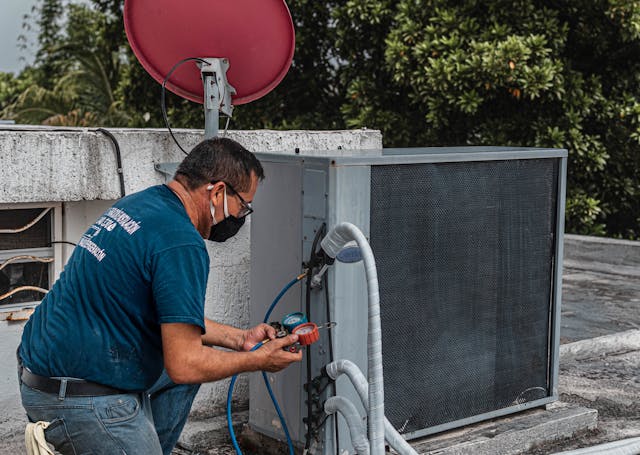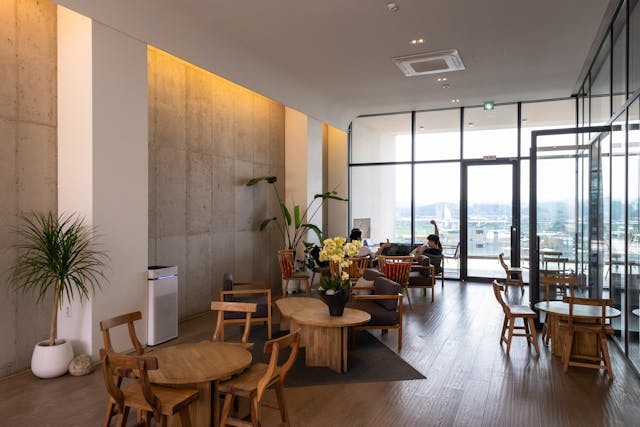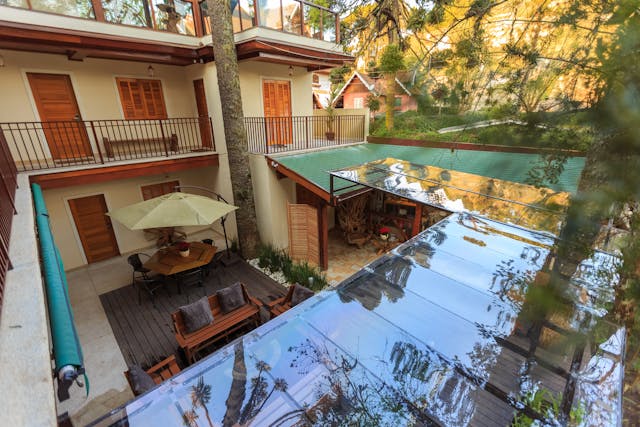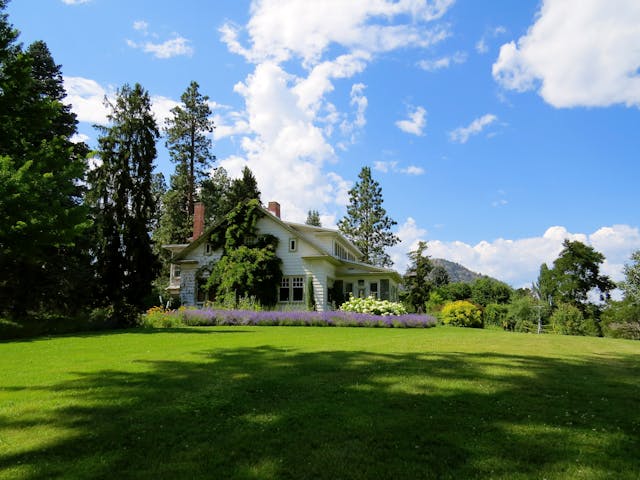- Beat the summer heat without breaking the bank! This checklist equips you for a cool and comfortable season.
- Optimize AC performance: Regular maintenance, strategic air filter changes, and smart thermostat use are your allies.
- Create cool outdoor escapes: Large patio umbrellas, shade sails, or retractable awnings offer delightful respite.
- Keep cool indoors: Invest in blinds that block sunlight and consider energy-efficient attic insulation.
- Sparkling pool, cool summer (if applicable): DIY maintenance or a professional service keeps your pool refreshing and safe.
Summer’s arrival brings sunshine, longer days, and, unfortunately, scorching temperatures. A well-maintained home is essential for staying cool and comfortable during this season. This comprehensive summer home maintenance checklist empowers homeowners to prepare their residences for the heat, potentially saving money on utility bills and preventing costly repairs down the line.
Here, we’ll explore ten key areas to address in your summer home maintenance checklist, providing actionable tips and insights to optimize your home for a cool and cost-effective summer.
Air Conditioning: Keeping Cool Without Breaking the Bank
A functional air conditioning (AC) system is vital for combating summer heat. Here’s how to ensure yours operates efficiently:
Schedule AC Maintenance

The Department of Energy estimates that a well-maintained AC unit can save homeowners up to 30% on cooling costs [1]. Schedule a professional AC maintenance service before summer kicks in. This service typically includes:
- Filter Cleaning: Dirty air filters can significantly reduce airflow and cooling efficiency. Replace or clean your air filter monthly for optimal performance.
- Coil Cleaning: Dust buildup on evaporator and condenser coils can impede heat transfer. A professional cleaning ensures proper heat exchange.
- System Inspection: Technicians will check refrigerant levels, electrical connections, and overall system health, identifying potential issues before they escalate into major AC repairs.
DIY AC Maintenance: Keeping Your Cool
Here are some basic AC maintenance tasks you can tackle yourself:
- Clean Air Filters: Regularly replace or clean your air filter, as your manufacturer recommends. A clean filter allows for optimal airflow and cooling efficiency.
- Clear Vents and Registers: Vacuum dust and debris from air vents and registers throughout your home to ensure proper airflow.
- Inspect Outdoor Unit: Turn off your AC and remove any leaves, branches, or debris blocking the outdoor unit’s condenser coils. A clear condenser allows for efficient heat exchange.
Smart Thermostats: Smarter Cooling
Consider investing in a smart thermostat. These Wi-Fi-enabled devices offer several benefits:
- Remote Programming: You can control your AC from anywhere using your smartphone, allowing you to make adjustments even when you’re away from home.
- Scheduling and Automation: Set custom schedules for temperature adjustments throughout the day and night. This can optimize cooling during off-peak hours and potentially reduce energy bills.
- Learning Capabilities: Some smart thermostats learn your habits and preferences, automatically adjusting temperatures for optimal comfort and efficiency.
Consider a Maintenance Contract
A maintenance contract with an HVAC (Heating, Ventilation, and Air Conditioning) company can offer peace of mind and potentially save money in the long run. These maintenance contracts typically include annual maintenance visits, discounted repairs, and priority service during peak seasons.
Evaluate your needs and compare different plans reputable HVAC companies offer before signing a contract.
Optimize AC Usage for Savings
Here are some everyday strategies to optimize AC usage and reduce energy bills:
- Adjust Thermostat Settings: When you’re home, set your thermostat to a comfortable yet efficient temperature, ideally between 78 and 80 degrees Fahrenheit.
- Utilize Ceiling Fans: Ceiling fans set to rotate counterclockwise create a cooling windchill effect, allowing you to raise the thermostat slightly for additional savings.
- Minimize Heat Gain: Close blinds or curtains on sun-facing windows during the day to prevent heat from entering your home.
- Seal Air Leaks: Inspect and seal air leaks around windows, doors, and electrical outlets. These leaks can significantly impact your AC’s efficiency.
Air Quality: Breathing Easy During Summer
Maintaining good indoor air quality is crucial for year-round comfort and health. Here’s how to ensure your home’s air stays fresh during summer:
Regularly Change Air Filters
As mentioned earlier, regularly replacing your air filter is essential for both AC efficiency and air quality. A clean filter traps dust, pollen, and other allergens that can exacerbate allergies and asthma symptoms.
Consider Air Purifiers

Air purifiers can significantly improve your indoor air quality. Here’s a breakdown of common technologies and their targets:
- HEPA (High-Efficiency Particulate Air) Filters: Capture microscopic allergens like dust, pollen, and pet dander, ideal for allergy and asthma sufferers.
- Carbon Filters: Adsorb and trap gaseous pollutants like smoke, odors, and volatile organic compounds (VOCs) released from building materials or cleaning products.
Choosing the Right Air Purifier
Air purifiers come in various types, each suited to specific needs:
- Allergy Relief: HEPA filters are essential for capturing allergy and asthma triggers like dust and pollen.
- Pet Dander Control: HEPA filters effectively remove pet dander, reducing allergy symptoms for pet owners.
- Smoke and Odor Removal: Look for air purifiers that combine HEPA and carbon filters to tackle smoke particles, cooking odors, and other gaseous pollutants.
Remember: Consider the air quality issues in your area and prioritize features that address your specific needs.
Enhance Ventilation
Proper ventilation allows fresh air to circulate, removing stale air and pollutants. Open windows on cooler mornings and evenings to improve natural ventilation. Ceiling fans can also help circulate air within your home
Pool Care: Maintaining a Sparkling Oasis

If you have a pool, proper maintenance is crucial for a refreshing and safe summer experience. Here’s a two-pronged approach to consider:
DIY Pool Maintenance
For homeowners comfortable with pool maintenance tasks, here are some essential steps:
- Skimming and Cleaning: Regularly skim leaves, debris, and insects from the pool surface. Clean the pool walls and floor with a pool brush to remove algae and buildup.
- Balancing Pool Chemicals: Maintain proper chlorine and pH levels in your pool water to ensure sanitation and prevent algae growth. Pool test strips and kits are readily available to monitor chemical levels.
- Shocking the Pool: Periodically shocking the pool with a chlorine shock treatment helps eliminate bacteria and contaminants not captured by routine chlorine levels.
Utilizing a Pool Maintenance Service
Those who prefer a hands-off approach should consider hiring a reputable pool maintenance service. Their services typically cover:
- Skimming, Cleaning, and Chemical Balancing: This ensures your pool remains clean, sanitized, and safe for swimming throughout the summer.
- Equipment Maintenance: Pool professionals can maintain your pool pump, filter, and other equipment, preventing costly breakdowns.
- Winterization (Optional): If you live in an area with harsh winters, pool service companies can properly winterize your pool to prevent damage from freezing temperatures.
Pool Covers: An Extra Layer of Protection
While a pool maintenance service can significantly ease the burden of pool care, consider investing in a pool cover for an extra layer of protection and potential cost savings. Here’s why:
- Reduces Cleaning Time: A pool cover prevents leaves, debris, and dirt from entering the pool, minimizing the time and effort needed for skimming and cleaning.
- Minimizes Chemical Use: Pool covers help reduce evaporation, reducing the amount of water lost and replenished. This translates to less frequent adjustments of pool chemicals like chlorine.
- Extends Pool Life: A pool cover helps prevent wear and tear on the pool liner and other components by shielding your pool from harsh sunlight and debris.
- Safety Benefits: A properly secured pool cover can be a safety barrier, especially for families with young children or pets.
Choosing the Right Pool Service for a Sparkling Summer
Keeping your pool clean and healthy can be time-consuming. If you’re considering hiring a pool service company, here are some key factors to evaluate:
- Experience and Reputation: Look for companies with a proven track record and positive customer reviews. Ask for references and check online reviews to gauge their service quality.
- Licensing and Insurance: Ensure the company is properly licensed and insured to protect yourself in case of accidents or property damage.
- Service Packages: Compare different service packages offered. Basic packages might cover cleaning and skimming, while premium options may include chemical balancing, equipment maintenance, and winterization. Choose a package that meets your pool’s needs and your budget.
Cost Considerations for Pool Maintenance
Pool service costs can vary depending on factors like pool size, location, service frequency, and the specific package chosen. Generally, you can expect to pay between $80 and $200 per week for professional pool maintenance services.
Creating Cool Comfort Zones: Patios and Outdoor Living
Summer is a time to make the most of your outdoor spaces. Here’s how to create cool and comfortable areas for relaxing and entertaining:

Embrace Shade with Large Patio Umbrellas
Large patio umbrellas provide much-needed shade on hot, sunny days. Consider these factors when choosing a patio umbrella:
- Size: Select a large enough umbrella to cover your desired patio area comfortably.
- Material: Canvas or solution-dyed polyester umbrellas offer good UV protection and durability.
- Tilt Mechanism: An adjustable tilt mechanism optimizes shade coverage throughout the day.
Caring for Your Patio Umbrella
Extend the lifespan of your patio umbrella with proper care:
- Cleaning: Regularly hose down the canopy to remove dirt and debris. For tougher stains, use a mild soap solution and a soft brush. Allow the umbrella to dry completely before storing.
- Storing: During off-seasons, store your umbrella upright in a clean, dry location. If possible, use a protective cover to shield it from dust, sun damage, and harsh weather.
- Maintenance: Tighten loose screws or bolts periodically to ensure the umbrella remains sturdy. Inspect the fabric for rips or tears and mend them promptly to prevent further damage.
Alternatives to Patio Umbrellas
While patio umbrellas offer portable shade, consider these alternatives for a more permanent solution:
- Retractable Awnings:
-
- Pros: Provide adjustable shade, make it easy to retract when not needed, and enhance curb appeal.
- Cons: Requires professional installation, can be expensive, may not offer as much coverage as a large umbrella.
- Shade Sails:
-
- Pros: Versatile shapes and sizes, unique aesthetic appeal, can be creative and stylish.
- Cons: May require multiple mounting points for stability, can flap in wind, may not offer the same level of sun protection as a solid umbrella canopy.
Consider Additional Shade Solutions
Beyond umbrellas, explore additional shade options for your patio:
- Retractable awnings: These awnings can be extended over patios when needed and retracted when not in use.
- Shade sails: These triangular or rectangular fabric panels suspended from poles can create unique and stylish shade areas.
- Climbing plants: Vines trained on trellises or pergolas can provide natural shade over time.
Keeping Cool Indoors: Blinds and Insulation

While outdoor shade solutions are crucial, managing indoor heat gain is equally important for summer comfort.
Utilize Blinds and Window Coverings
Blinds and window coverings can significantly impact your home’s cooling efficiency:
- Blackout Blinds: These light-blocking blinds are particularly effective in bedrooms, preventing sunlight from heating up the room and promoting better sleep during hot weather.
- Reflective Blinds: Blinds with a reflective backing can help deflect sunlight away from your windows, reducing heat gain within your home.
- Cellular Shades: These honeycomb-shaped shades trap air, providing an insulating effect that can help keep your home cooler in the summer.
Window Tint: A Cool Consideration
Window tinting film can be a valuable addition to your summer home maintenance strategy. Here’s why:
- Reduced Heat Gain: Window tint helps block solar heat radiation, lowering your cooling needs and potentially reducing energy bills.
- UV Protection: Tinting films block harmful UV rays, protecting your furniture and interiors from fading. It can also offer some protection for your skin from UV exposure near windows.
Aesthetic Considerations:
While functional, window tint can affect the look of your home. Here’s what to keep in mind:
- Visible Light Transmission: Tints vary in darkness, impacting the amount of natural light entering your home. Choose a level that balances heat reduction with desired light intake.
- Curb Appeal: Darker tints can alter the exterior appearance of your home. Consider local regulations and choose a tint that complements your home’s style.
DIY Blind Installation Tips
For the DIY enthusiast, blind installation can be a rewarding project. Here’s a basic guide:
- Measure Accurately: Measure window width and height in multiple spots to ensure proper blind fit.
- Gather Tools: Screwdrivers, a level, and a drill are commonly needed for blind installation (depending on the blind type).
- Follow the Instructions. The Manufacturer’s instructions provide detailed steps for mounting brackets and hanging blinds. Ensure everything is level and secure before use.
Remember: Safety first! Consult a professional for electrical work or if you’re unsure about any steps during the installation process.
Invest in Proper Attic Insulation
The U.S. Department of Energy reports that proper attic insulation can reduce summer cooling costs by up to 30% [2]. Heat rises, so ensuring your attic is adequately insulated prevents heat from radiating down into your living space.
DIY Attic Insulation Installation
For experienced DIYers, attic insulation installation can be a cost-effective project. However, it’s crucial to choose the right type of insulation (e.g., fiberglass batts, blown-in cellulose) and follow proper installation techniques to avoid safety hazards and ensure optimal performance.
Attic Insulation Services (Hiring Professionals)
Hiring professional attic insulation services offers several advantages:
- Expertise: Professionals can recommend the most suitable insulation type and thickness for your climate and attic structure.
- Safety: They ensure safe installation practices, especially when dealing with electrical wiring or ventilation systems in the attic.
- Efficiency: Professionals can typically complete the installation process quickly and efficiently.
Types of Attic Insulation:
- Fiberglass Batts (Pros): Affordable, readily available, easy to install (DIY friendly).
- Cons: Not as effective as other options, can settle over time, may irritate skin or eyes.
- Cellulose Insulation (Pros): Excellent for irregular spaces; good soundproofing and fire-resistant options are available.
- Cons: Can be heavier than fiberglass, requires professional installation for optimal results.
- Spray Foam Insulation (Pros): Superior insulation value, creates an air barrier and is moisture resistant.
- Cons: Most expensive option, requires professional installation, can be messy during application.
Government Incentives for Attic Insulation:
Good news! Investing in attic insulation can be financially rewarding. The U.S. government offers a tax credit for a portion of qualified energy-efficient home improvements, including insulation [3]. Some states and local municipalities also provide rebates or incentives for energy-efficient upgrades. Research programs available in your area to maximize potential savings on your attic insulation project.
Proactive Plumbing Maintenance: Avoiding Summer Headaches
While this guide focuses on summer-specific maintenance tasks, don’t neglect your home’s plumbing system. Here are some proactive measures to prevent plumbing problems that could disrupt your summer fun:
- Schedule a Plumbing Checkup: Consider having a licensed plumber perform a preventative maintenance check-up on your plumbing system. This could involve inspecting pipes for leaks, checking water pressure, and ensuring all drains are clear.
- Address Minor Issues Promptly: A small leak today can become a major headache tomorrow. Don’t ignore leaky faucets, dripping pipes, or sluggish drains. Addressing minor issues promptly can save you money and prevent further damage.
- Know Where Your Shutoff Valve Is: Familiarize yourself with the location of your main water shutoff valve. In case of a major leak, knowing where this valve is located allows you to shut off the water supply and minimize potential damage quickly.
Signs You Might Need a Plumber:

If you experience any of the following plumbing issues, it’s advisable to contact a licensed plumbers for diagnosis and repair:
- Leaky faucets or pipes
- Clogged drains
- Running toilets
- Low water pressure
- Unusual noises coming from your pipes
By taking these proactive steps, you can minimize the risk of plumbing problems and ensure a smooth sailing summer season in your home.
FAQs (Frequently Asked Questions)
- Q: How often should I change my air conditioner filter?
- A: Ideally, replace your air filter monthly during peak cooling months (summer) and every 2-3 months during milder seasons.
- Q: Can I clean my pool myself, or should I hire a professional?
- A: If you’re comfortable with pool maintenance tasks like skimming, cleaning, and balancing chemicals, DIY pool care is a viable option. However, for those who prefer a hands-off approach or lack the time, hiring a reputable pool maintenance service ensures your pool remains clean, sanitized, and safe for swimming throughout the summer.
- Q: What type of blinds are best for keeping my home cool in the summer?
- A: Blackout blinds are excellent for bedrooms, blocking sunlight and promoting cooler sleeping temperatures. Reflective blinds can also be effective, deflecting sunlight away from windows and reducing heat gain. Cellular shades offer an additional benefit of insulation, trapping air and further minimizing heat transfer through windows.
- Q: Should I install attic insulation myself or hire a professional?
- A: For experienced DIYers with proper knowledge of insulation types and installation techniques, DIY attic insulation can be a cost-saving option. However, professional installation offers several advantages, including expertise in choosing the right insulation type and thickness, ensuring safety during installation, and completing the project efficiently.
People Also Ask
- How can I save money on my summer electricity bill?
- This blog post provides numerous tips for saving money on your summer electricity bill, including regular AC maintenance, optimizing AC usage (adjusting thermostat settings, utilizing ceiling fans, minimizing heat gain), and strategically using blinds and insulation to keep your home cooler.
- What are the signs that my air conditioner needs repair?
- Common signs that your AC might need repair include uneven cooling throughout your home, weak airflow, unusual noises coming from the unit, and increased energy bills. If you experience any of these issues, it’s advisable to consult a qualified HVAC technician for diagnosis and repair.
- How can I improve the air quality in my home?
- This blog post highlights several strategies for improving your home’s air quality: regularly changing air filters, considering air purifiers for additional filtration, and enhancing ventilation by opening windows and using ceiling fans.

